- Joined
- Oct 9, 2007
- Messages
- 47,598 (7.45/day)
- Location
- Dublin, Ireland
| System Name | RBMK-1000 |
|---|---|
| Processor | AMD Ryzen 7 5700G |
| Motherboard | Gigabyte B550 AORUS Elite V2 |
| Cooling | DeepCool Gammax L240 V2 |
| Memory | 2x 16GB DDR4-3200 |
| Video Card(s) | Galax RTX 4070 Ti EX |
| Storage | Samsung 990 1TB |
| Display(s) | BenQ 1440p 60 Hz 27-inch |
| Case | Corsair Carbide 100R |
| Audio Device(s) | ASUS SupremeFX S1220A |
| Power Supply | Cooler Master MWE Gold 650W |
| Mouse | ASUS ROG Strix Impact |
| Keyboard | Gamdias Hermes E2 |
| Software | Windows 11 Pro |
EVGA has been teasing its flagship GeForce RTX 2080 Ti Kingpin graphics card for well over a month now, and we've finally had a chance to pick one up in the flesh. This card is every professional overclocker's liquid-cooled wet-dream, with a PCB designed with inputs from Vince "Kingpin" Lucido, and a hybrid AIO-CLC cooling solution. The PCB features a 19-phase VRM that pulls power from three 8-pin PCIe power connectors located at the tail end of the card. The CLC makes contact with the GPU, while a copper base-plate, mated with several copper heatsinks over the memory and VRM areas, offload some of their heat to the block. A 100 mm fan ventilates some of these heatsinks.
A 120 mm radiator is on the other end of the card's CLC. This time around, the cooler actually serves a significant function besides being something you rip apart to install your LN2 evaporator: the shroud is studded with an LCD display with a limited feature-set resembling that of the EVBot. Right next to this LCD are diagnostic LEDs, voltage measurement points, a BIOS selector switch, and headers for a full-featured EVBot-like device. The GPU and memory chips are hand-binned for this card, and most of its electrical components are sourced from top bins. These come together for an ungodly amount of overclocking headroom not just with exotic DIY cooling, but also out of the box.
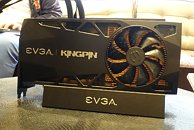
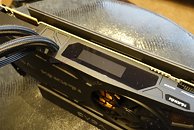
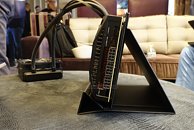
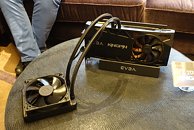
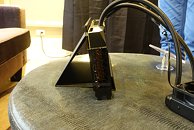
View at TechPowerUp Main Site
A 120 mm radiator is on the other end of the card's CLC. This time around, the cooler actually serves a significant function besides being something you rip apart to install your LN2 evaporator: the shroud is studded with an LCD display with a limited feature-set resembling that of the EVBot. Right next to this LCD are diagnostic LEDs, voltage measurement points, a BIOS selector switch, and headers for a full-featured EVBot-like device. The GPU and memory chips are hand-binned for this card, and most of its electrical components are sourced from top bins. These come together for an ungodly amount of overclocking headroom not just with exotic DIY cooling, but also out of the box.





View at TechPowerUp Main Site







